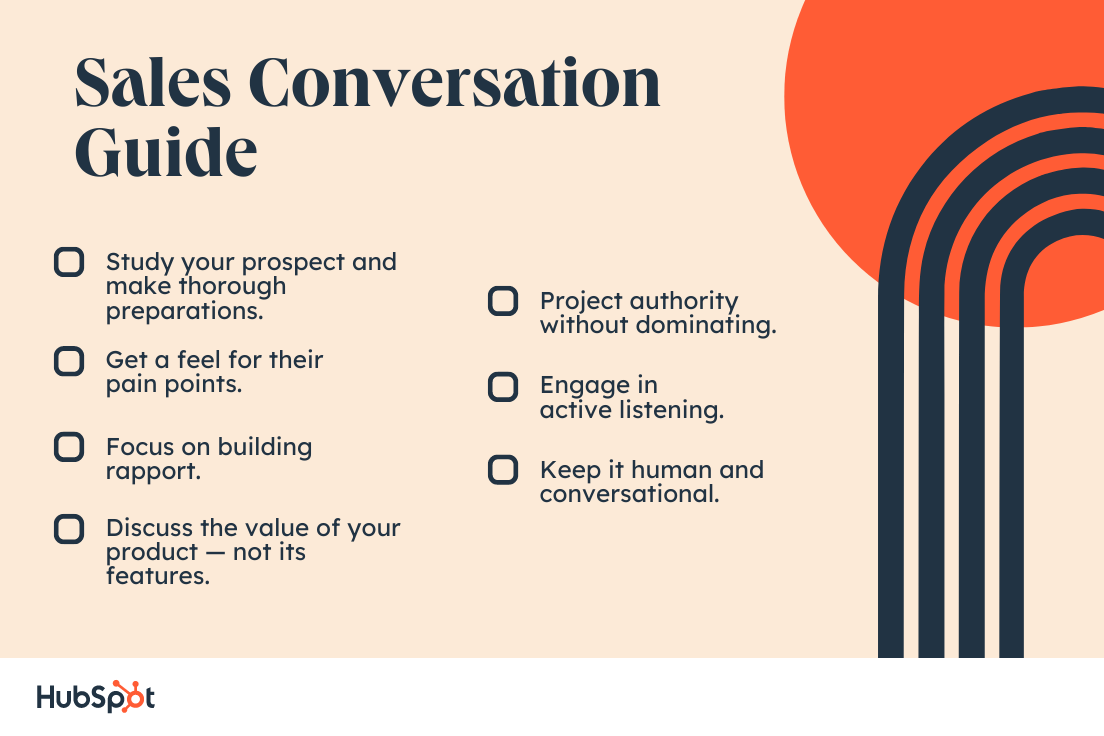Having conversations with prospects is baked into sales — in a lot of ways, it's the basis of the whole concept.
You have to successfully initiate and conduct productive sales conversations if you want to thrive in a sales role. Being able to thoughtfully and adeptly communicate with prospects in-person, over the phone, and via email will set you up for a long and successful career in the field.
Free Download: Sales Plan Template
But sales conversations aren't always straightforward, and your ability to nail one rests on a few key elements that aren't necessarily obvious. So to help you out, we'll discuss what sales conversations are and help you get the most out of your direct communication with prospects and customers.
What is a sales conversation?
A sales conversation is a dialog between a seller and a potential customer to persuade them to purchase a product or service. The seller typically identifies the customer's needs, presents the product as a solution, and overcomes objections to closing the sale.
Now it may seem straightforward, but salespeople have to hold sales conversations that are convincing, trustworthy, and engaging — which adds a few more steps to the process.
How to Start a Sales Conversation
- Prepare, prepare, and prepare some more.
- Have a strong feel for their pain points.
- Focus on building rapport.
- Discuss the value of your product — not its features.
- Project authority without dominating.
- Listen.
- Keep it human and conversational.

1. Study your prospect and make thorough preparations.
You need some degree of familiarity with your prospect before launching into a sales conversation. If you don't, your core value proposition will come off as generic, making the dialogue around it impersonal and underwhelming.
A sales conversation is an opportunity to speak to a prospect's unique challenges and demonstrate why you, specifically, are best equipped to address them. You can't do that without doing your research.
Familiarize yourself with essential knowledge such as the prospect's:
- Title
- Industry
- Market Position
- How your product or service has helped similar companies
- Solutions they're currently leveraging (if possible)
You want to come off as both actively interested in their organization and knowledgeable about its circumstances.
2. Get a feel for their pain points.
This point is an extension of the one above. Understanding your prospect's pain points might be the most important byproduct of all your preparation. Remember, talking with a prospect about their business — not some vague monolith of businesses in general.
That's why your value proposition has to be relevant and personal. Each company has its own qualities, interests, and needs, and you need to determine the specific pain points that stem from those elements.
Components of your research relating to factors like a company's industry, scale, market position, competitive landscape, current solutions leveraged, and performance should be very telling into the kinds of problems it might be dealing with. Notes and insights from any previous conversations can also provide an excellent reference point for this step.
3. Focus on building rapport.
A successful sales conversation is rooted in trust and comfort. According to HubSpot blog research, 40% of sales professionals believe establishing customer trust and rapport is essential to sales strategy. You need to put your prospect at ease. If you can do that, they'll be in the best possible position to hear and entertain your value proposition.
Do what you can to build rapport with your prospect. Make your conversation as familiar and natural as possible. That means making a point of finding common ground, demonstrating a sincere interest in their business, being friendly, and — above all — being yourself.
Very few people are inclined to buy from someone they don't mesh with, and if you're too awkward, robotic, or overbearing, you'll have a hard time developing that chemistry. A sales conversation is just that — a conversation — so approach yours with a mentality that reflects that.
4. Discuss the value of your product — not its features.
Most sales conversations are less about selling your solution — and more about selling what your solution can do for your prospect. Sitting down and rattling off all the bells and whistles your product or service boasts won't do too much for you.
A value proposition is called a value proposition for a reason. You're trying to stress the ultimate value your product or service can provide — if it were strictly about features, it would be called a feature proposition.
For instance, if you're selling a conversational intelligence platform, don't just talk about the fact that it provides real-time transcripts. Talk about how the data and insight you can gather from those transcripts can decrease the average time it takes to ramp new reps and how that can impact a sales organization's bottom line.
Ultimately, your prospects won't care about your solution's features if you can't show how applying those features can improve their companies' operations.
5. Project authority without dominating.
Confidence is key when conducting sales conversations, but there's a line between confidence and arrogance. Your prospects want to know that you know what you're doing, and that takes a certain degree of assertiveness — but they still need to be able to air their thoughts.
Avoid talking over your prospects and be mindful of whether they can get a word in edgewise. At the same time, don't just sit back and let them run the show. Both parties have a stake in the conversation, so make sure there's some give and take.
Hear them out, and use your expertise and experience to offer viable, relevant answers to their questions as they come up. Remember, you're in the driver's seat here, but don't act like you're the only one in the car.
6. Engage in active listening.
When your prospect talks, you have to actively listen and absorb what they're saying. As I've mentioned, a sales conversation should never be one-sided. Your prospect stands to gain or lose a lot based on how it goes, so you should let them have their place in it.
Listening helps you more effectively tailor your pitch to suit your prospect's needs as the conversation happens. They might air pain points you haven't considered, stress specific needs you should pay closer attention to, name-drop certain competitors, or offer any other insight to help you create a more thoughtful value proposition.
7. Keep it human and conversational.
Successful sales conversations are rarely rigid and overly rehearsed. Remember, they're conversations, so you're best off keeping them accessible, conversational, and at least somewhat relaxed.
Don't go in with a sales script you're afraid to deviate from. Leave room for improvisation, off-the-cuff remarks, and friendly back and forth. I mentioned this earlier, but no one wants to buy from someone who sounds stiff and robotic.
Prospects are most inclined to buy when they're comfortable. Always keep that in mind when conducting your sales conversations, and tailor your tone, language, and general attitude to put them at ease.
Effective Sales Communication is Key
Ultimately, sales conversations — like virtually any other sales aspect — should revolve around solving for the customer. Lead with empathy, make sure your prospect is comfortable, and present a solution for them. If you can cover those bases, you can conduct productive sales conversations.
Editor's note: This article was originally published in May 2021 and has been updated for comprehensiveness.
Sales Communication




![Active Listening Techniques To Use On Your Next Sales Call [+ Examples]](https://53.fs1.hubspotusercontent-na1.net/hubfs/53/active-listening-1-20250218-4164086.webp)
![How to Reply to a Sales Rejection Email From a Client [+ Templates]](https://53.fs1.hubspotusercontent-na1.net/hubfs/53/timing-objection-responses-1.jpg)




%20(1).png)

